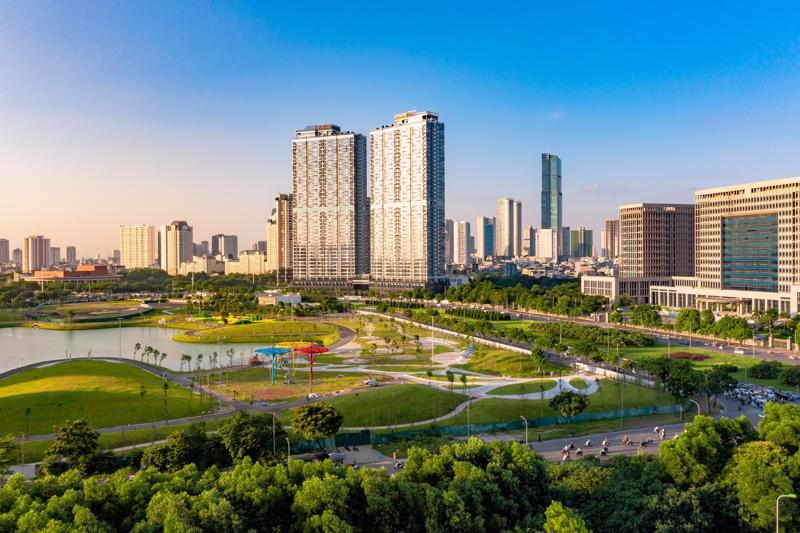Foreign developers are pouring billions into Vietnam's burgeoning northern real estate market, signaling confidence in the region's economic outlook and its evolving role within global supply chains.
Their investment strategies are diversifying, says Trang Bui, Country Head of Cushman & Wakefield Vietnam. What began over a decade ago with direct development projects, now includes a range of activities like mergers and acquisitions as well as the formation of investment funds.
This influx of foreign direct investment (FDI) positions Hanoi and five key northern provinces among Vietnam's top 10 FDI hotspots. In 2023 alone, they secured a combined $16.7 billion in investment, reports the Ministry of Planning and Investment.
This growth comes amid broader positive trends including macroeconomic stability, policy improvements, strong domestic demand, and technological advancements.
Major investments fueling this expansion include a $2 billion Thai Binh thermal power plant, a $1.5 billion Jinko Solar project in Quang Ninh, a $1 billion investment by LG Innotek in Hai Phong, and Amkor Technology's $1.6 billion semiconductor factory in Bac Ninh.
"The northern market has become exceptionally attractive due to its infrastructure transformation," explains Ms. Bui. Accessibility within the region has soared thanks to a network of expressways and ambitious plans for major ring roads.
This connectivity, coupled with its proximity to China, makes the North ideal for manufacturers seeking to diversify supply chains as part of the "China 1" strategy.
Shifting Markets, Greener Trends
The North's retail scene is buzzing with activity and a shift in consumer preferences. The recent Lotte Mall Tay Ho launch brought over 20 new brands to Vietnam, with even more retail space planned for the area by 2030.
Spurred by rising incomes, Vietnamese shoppers are increasingly spending on services and experiences like concerts, travel, and sports. Global retailers like Central Retail are taking note, expanding their presence with project like GO! Ha Nam.
Cushman & Wakefield forecasts at least 57 new retail developments across the North by 2033.
For decades, the North has been integral to global manufacturing. This legacy continues, bolstered by robust infrastructure. As of early 2024, available industrial land in the region spans 14,600 hectares across 71 projects, with Cushman & Wakefield projecting an additional 30,000 hectares within the next decade.
Underscoring the investment wave are two key trends: the ongoing expansion of basic goods manufacturing as global businesses reconfigure supply chains, and a push into higher value-added sectors like semiconductors and electronics.
The ready-built factory and warehouse market, while relatively new, is also booming and expected to swell to 17 million square meters in the next decade.
Notably, green development is making inroads. Vietnam boasts around 150 LEED-certified projects, primarily concentrated in industrial real estate, yet lacks clear standards for large-scale green industrial parks.
Hospitality, Offices, and Housing
The hospitality sector, catering mainly to business and leisure travelers, has a current capacity of about 20,000 rooms across 104 four and five-star hotels.
Global hotel chains like IHG, Accor, and Marriott have a growing presence. The market is poised to nearly double by 2033 with an additional 34,000 rooms in the pipeline.
Meanwhile, office trends favoring shared and hybrid workspaces persist. Tech, logistics, and professional services firms are key tenants. Tech giant Samsung is a major driver of office space demand, with massive smartphone manufacturing operations near Hanoi.
Hanoi and Hai Phong will become prime office hubs with around 3.2 million square meters of supply expected by 2033. This influx of space could put downward pressure on rents, forcing landlords to prioritize ESG (Environmental, Social, and Governance) features to attract tenants.
The North's residential market, somewhat dampened by uncertainties surrounding changes to the Land Law, is still massive. It currently has 370,000 apartments with supply surging towards 650,000 by 2033.
New 'satellite cities' are rising in Quang Ninh and Hai Phong. Landed housing is also booming, with developers increasingly prioritizing sustainability and lifestyle amenities.
"Sustainable development requires the right strategies now," stresses Ms. Bui. She highlights 'placemaking,' where spaces are accessible to all users, as a key concept gaining traction in project planning across the North.









 Google translate
Google translate